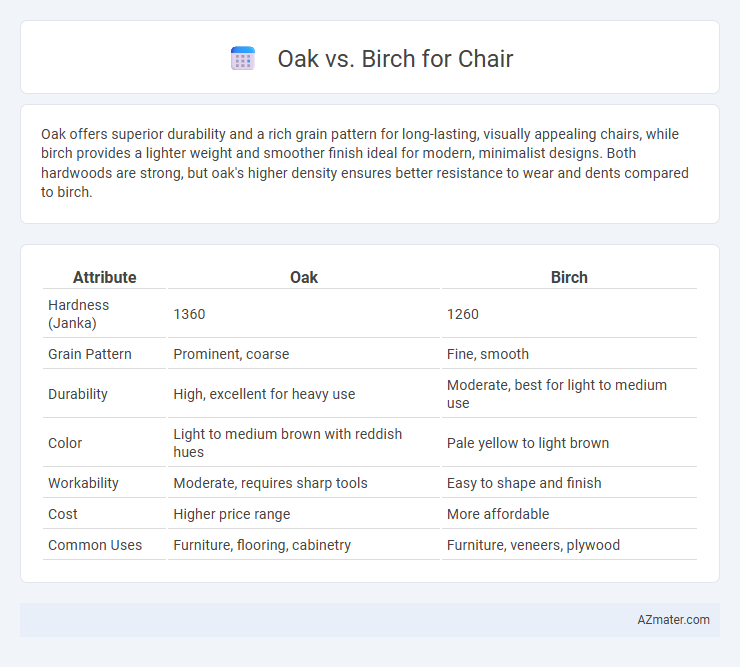Oak offers superior durability and a rich grain pattern for long-lasting, visually appealing chairs, while birch provides a lighter weight and smoother finish ideal for modern, minimalist designs. Both hardwoods are strong, but oak's higher density ensures better resistance to wear and dents compared to birch.
Table of Comparison
| Attribute | Oak | Birch |
|---|---|---|
| Hardness (Janka) | 1360 | 1260 |
| Grain Pattern | Prominent, coarse | Fine, smooth |
| Durability | High, excellent for heavy use | Moderate, best for light to medium use |
| Color | Light to medium brown with reddish hues | Pale yellow to light brown |
| Workability | Moderate, requires sharp tools | Easy to shape and finish |
| Cost | Higher price range | More affordable |
| Common Uses | Furniture, flooring, cabinetry | Furniture, veneers, plywood |
Introduction to Oak and Birch Wood
Oak wood, known for its durability and pronounced grain patterns, is a popular choice for crafting sturdy and long-lasting chairs. Birch wood features a fine, uniform texture with a pale color that offers a smooth finish, making it ideal for chairs requiring a refined appearance. Both hardwoods provide excellent strength, but oak tends to be heavier and more resistant to wear, while birch is easier to shape and stain for versatile chair designs.
Characteristics of Oak Wood
Oak wood features high density and exceptional durability, making it ideal for long-lasting chairs that withstand daily use. Its coarse grain pattern and natural resistance to wear and moisture provide stability and a classic aesthetic appeal. Oak's hardness ranges from 1,200 to 1,360 on the Janka scale, surpassing birch, which contributes to the chair's structural integrity and longevity.
Features of Birch Wood
Birch wood offers a smooth, fine grain texture and light color that enhances modern chair designs, providing a sleek and elegant appearance. It is known for its strength and durability, making chairs sturdy and long-lasting while remaining relatively lightweight compared to oak. Birch also machines well and takes stains evenly, allowing versatile finishes that highlight the natural beauty of the wood in furniture craftsmanship.
Durability Comparison: Oak vs Birch
Oak offers superior durability compared to birch, with a Janka hardness rating of approximately 1,290, making it highly resistant to dents and wear in chair construction. Birch has a lower Janka hardness around 1,260, providing adequate strength but less impact resistance over time. For long-lasting chairs subjected to heavy use, oak's dense grain structure ensures better longevity and structural integrity.
Appearance and Grain Differences
Oak chairs display a prominent, coarse grain with distinctive rays and growth rings, contributing to a robust and rustic appearance ideal for traditional or farmhouse styles. Birch chairs feature a smoother, fine grain with subtle color variations, offering a clean, contemporary look well-suited for modern or minimalist designs. The grain contrast in oak provides texture and depth, whereas birch's uniform grain enhances sleekness and simplicity in furniture aesthetics.
Workability and Ease of Construction
Oak offers excellent workability due to its strong, dense grain, making it ideal for sturdy chair frames that require precise joinery and durability. Birch has a fine, uniform texture that allows for smooth sanding and detailed carving, providing ease of construction for intricate chair designs. While oak demands sharper tools for cutting and shaping, birch's softer nature reduces wear on equipment, facilitating faster assembly without sacrificing strength.
Cost and Availability
Oak chairs generally cost more due to the wood's density and durability, making them a long-lasting investment. Birch is more affordable and widely available, often sourced from abundant forests, which helps keep prices lower. Both woods are popular for furniture, but oak's higher price reflects its premium quality and slower growth rate compared to birch.
Environmental Impact and Sustainability
Oak chairs offer durability and long-lasting use, reducing the need for frequent replacement and minimizing environmental waste. Birch grows faster than oak, supporting sustainable forestry practices by replenishing resources more quickly. Both hardwoods can be sourced from certified sustainably managed forests, but birch's rapid growth makes it a more eco-friendly option for environmentally conscious furniture.
Best Uses for Oak and Birch Chairs
Oak chairs are renowned for their strength and durability, making them ideal for high-traffic areas such as dining rooms and offices where long-lasting furniture is essential. Birch chairs offer a smooth finish and lighter weight, which suits casual seating and modern design aesthetics in living rooms or bedrooms. The dense grain of oak provides excellent resistance to wear, while birch's flexibility allows for intricate shapes and comfortable seating designs.
Conclusion: Which Wood is Better for Chairs?
Oak offers superior durability and strength, making it ideal for chairs designed to withstand heavy use and provide long-lasting support. Birch provides a smoother grain and lighter color, appealing for aesthetic purposes but is less resistant to dents and scratches compared to oak. Therefore, oak is generally the better wood for chairs requiring maximum sturdiness and longevity.

Infographic: Oak vs Birch for Chair
 azmater.com
azmater.com